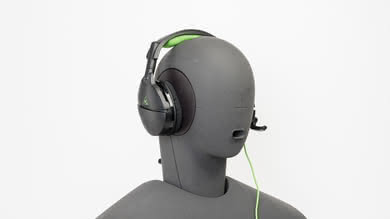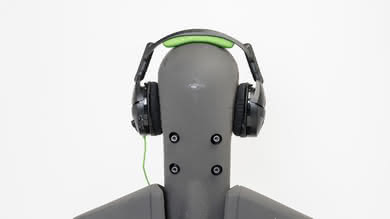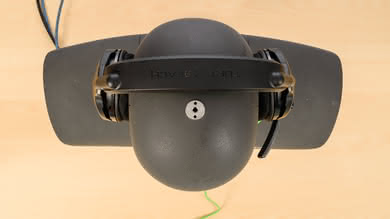The Turtle Beach Stealth 300 are decent wired gaming headphones. They have the same design and build quality as the Turtle Beach Stealth 600 Wireless, so they're comfortable and easy-to-use, but look a bit cheap and won't be as durable as some of the other budget gaming headsets we've tested. Unfortunately, they don't block a lot of noise, they leak a lot, and you can't use them passively, despite being wired, which is disappointing.
Our Verdict
The Turtle Beach Stealth 300 are mediocre for mixed usage. They have a wired design, which makes them slightly more versatile than the Turtle Beach Stealth 600 since you can use them with your phone and both Xbox and PS4 controllers. However, they won't be as convenient for gaming because you're limited by the range of the cable. They also don't have a lot of customization options since they don't support the Turtle Beach Audio Hub. Other than that, they have the same design as the 600, so they won't be the best for outdoor use. They look a little cheap and plasticky but should be comfortable enough for most.
- Above-average audio reproduction.
- Decent controls for gaming.
- Good battery life.
- Poor noise and leakage isolation.
- Plasticky and cheap-feeling build quality.
- Lacking good customization options.
The Turtle Beach Stealth 300 are above-average for neutral listening. They have a decently balanced sound profile with a lot of bass, a decent mid and treble range, and a fairly consistent reproduction even with listeners that wear glasses. Unfortunately, their bass range can sometimes sound a bit boomy. Their treble range lacks a bit of detail and presence on vocals and lead instruments. On the upside, they have some sound customization options.
The Turtle Beach Stealth 300 are below-average for commuting. They don't block enough noise for loud environments. They're also bulky and don't have a detachable mic but on the upside, they're comfortable and easy-to-use.
The Turtle Beach Stealth 300 are mediocre-at-best for sports and fitness. They have a bulky design that's not stable enough to run with, and they have low breathability, so your ears may get uncomfortably warm if you work out with them. They're also wired, which means they'll work with your phone but can also be yanked off your head if the cable snags on something.
The Turtle Beach Stealth 300 are mediocre-at-best for office use. They leak a lot and don't isolate well in loud environments. On the upside, they're comfortable and have a good control scheme. They also have long battery life.
Being wired headphones, the Turtle Beach Stealth 300 aren't suitable for wireless gaming.
The Turtle Beach Stealth 300 are decent for gaming. These headphones have low latency, a comfortable design that you can wear for hours, and above-average sound quality. They don't have the convenience of a wireless design like some of the other gaming headsets we've tested, but they have a decent mic that filters a lot of noise and accurately reproduces your voice.
Changelog
- Updated Nov 21, 2019: Converted to Test Bench 1.3.1.
- Updated Nov 21, 2019: Converted to Test Bench 1.3.
- Updated Jun 26, 2019: We've updated the Feedback score to better represent the responsiveness of the buttons.
- Updated Aug 17, 2018: Review published.
Check Price
Popular Headphones Comparisons

The Turtle Beach Stealth 300 is a decent wired gaming headset but doesn't have many features or connection options. These headphones have a 26-hour continuous battery life that can easily last you long enough for most gaming marathons, and also have an auto-off feature to conserve power when inactive. Unfortunately, their build quality is mediocre-at-best. Like the Turtle Beach Stealth 600 Wireless, they feel a little cheap and not as durable as other headsets. They also don't have many customizable features, apart from the built-in presets that you can cycle through with the 'Mode' button on the right ear cup. See our recommendations for the best PS4 headsets.
The Turtle Beach Stealth 300 are a better, wired headset than the Turtle Beach Recon 50X. The Stealth 300 have a better-built design that's more comfortable to wear during long gaming sessions. They also feel a lot more durable than the Recon 50X and have a better-balanced sound that caters to a greater genre of music and games. They also come with 3 other audio profiles you can cycle through. The only factors that should make you choose the Recon 50X over the Stealth 300 are price and battery life, since the 50X are completely passive, unlike the 300 which run out of battery and have no passive playback.
The Astro A10 are better wired gaming headphones than the Turtle Beach Stealth 300. The Astro have a better build quality with a more premium-looking design than the Turtle Beach. They also sound better and have a better boom mic for voice chat. The Turtle Beach, however, are more comfortable than the Astro since they're not as tight on the head. While neither can connect to a companion app, the Turtle Beach let you cycle between four audio presets via their controls. The Astro can't be customized at all.
The Turtle Beach Stealth 600 and the Turtle Beach Stealth 300 are very similar, apart from differences in connectivity. The Stealth 600 have a greater range since they're wireless, so you can more conveniently game from your couch. However, since the Stealth 300 are wired, they're compatible with all consoles and mobile devices that have a regular audio jack.
The Turtle Beach Stealth 700 Wireless are a better gaming headset overall than the Turtle Beach Stealth 300. The Stealth 700 have a lot more connectivity options than the 300. They also have a headphone jack and a USB dongle that has low latency for wireless gaming. They're noise cancelling too, although it doesn't really reduce much background noise. On the upside, since the Stealth 300 don't have as many active features and connection options, they have an excellent battery life that will last you longer than the Stealth 700. As they're wired, the range of their audio cable can be limiting for some.
Test Results
The Turtle Beach Stealth 300 look almost identical to the Turtle Beach Stealth 600 Wireless. They're a wired variant of the same headset, and also have large ear cups and a wide headband with a decent amount of padding. They have a slightly different yoke design that shows the metal at the center of the frame. Unfortunately, like the wireless model, the breathable fabric used for the pads looks and feels a bit cheap. They also have a typical gaming design, with color accents that match the console variant purchased. Unfortunately, they're not the most stylish-looking or outdoor-friendly, unlike some of the HyperX gaming headsets we've tested.
The Turtle Beach Stealth 300 are the same comfort-wise as the Turtle Beach Stealth 600 Wireless. They're also a bit tight on the head, but the spacious ear cups fit comfortably around most ears. The headband and ear cups are decently well-padded, although the fabric covering the ear cup pads doesn't feel as nice on the skin as the faux-leather of some of the other headphones we've tested. On the upside, they have a slight dip in the ear cup padding to better fit listeners who wear glasses.
Update 06/26/2019: After testing the Turtle Beach Recon 70, we revisited the Feedback score, which we felt was previously scored too harshly. The score has been adjusted.
The Turtle Beach Stealth 300 have the same button layout as the Turtle Beach Stealth 600 Wireless despite having slightly less functionality. They provide a volume and microphone dial, as well as a fold-up-to-mute feature to completely disable the mic. They also have two buttons on the left ear cup to switch between four audio presets and to turn on/off the headphones. It's an easy-to-use and decently responsive control scheme.
The Turtle Beach Stealth 300 are somewhat breathable, thanks to the porous fabric used for the ear cup pads. However, since they create a decent seal around your ears, they do obstruct a fair bit of airflow which will make your ears quite warm after a couple of hours of gaming. They're not as bad as some of the other over-ears, but the temperature difference is noticeable.
Like most gaming headphones, the Turtle Beach Stealth 300 aren't very portable. They're big and bulky with large ear cups that only lay flat and don't fold into a more compact format. They're a hassle to carry on you if you don't have a bag or a backpack and don't come with a case or pouch, which is slightly disappointing. On the upside, since they're wired, you can use them outdoors with your phone if you want to, unlike the Turtle Beach Stealth 600 which have the same design but are limited by their USB transmitter.
The Turtle Beach Stealth 300 don't come with a case or pouch.
The Turtle Beach Stealth 300, like the similarly designed Turtle Beach Stealth 600 Wireless, have a plasticky build quality that doesn't feel as durable as some of the other gaming headsets we've tested. The ear cups are decently dense and shouldn't get damaged by a couple of accidental drops. The headband is also flexible enough to handle the physical stress of most casual use. Unfortunately, the frame and hinges feel fragile and cheap. They have slightly different yokes that expose a metal center; however, they don't feel that much more durable than the 600.
These headphones aren't made for sports. They're a bit tight on the head, so they don't move too much during more casual activities like gaming. However, since they're not made for physical activities, they're cumbersome and sway quite a bit when running. They can quickly fall off your head if you use them for working out. They also have a non-detachable cable that can yank the headphones off your head if it gets hooked by something.
The Turtle Beach Stealth 300's frequency response consistency is very good. The bass delivery across our human subjects was quite consistent, with the maximum deviation being less than 3dB at 20Hz. Their treble delivery across multiple re-seats was even more consistent than their bass range, which is probably due to their relatively small ear cups.
The Turtle Beach Stealth 300 have good bass accuracy. Their LFE (low-frequency extension) is at 10Hz, which is excellent. This indicates a deep bass that is capable of producing thumps and rumbles common to EDM, hip-hop, and film scores. Additionally, the range's response is quite flat but consistently overemphasized by about 4dB, which makes the sound boomy but fans of heavy bass may like it. Overall, the bass is deep and well-balanced, but noticeably heavy.
The Turtle Beach Stealth 300's mid accuracy is very good. Low-mid, mid-mid, and high-mid are a bit uneven but overall decently balanced. This ensures clear reproduction of vocals and lead instruments. The mismatch between the L/R drivers in the graph isn't considered an issue in the frequency response, but they'll get penalized for it in the Imaging section.
The Turtle Beach Stealth 300's treble accuracy is good. The response is rather uneven and generally underemphasized. Low-treble is underemphasized by about 3dB, and mid-treble by about 1dB. Overall, their treble is quite well-balanced, but a tad veiled and lacking in detail and brightness.
The imaging is great. Their weighted group delay never crosses the audibility threshold, resulting in a tight bass and transparent treble reproduction. Also, the L/R drivers of our test unit were pretty well-matched in amplitude and phase response but showed some mismatch in the frequency response of their bass and mid ranges. This could create inconsistencies in the stereo image but won't have a significant negative effect on the placement and localization of objects (voice, instruments, footsteps), in the stereo image. However, these results are only valid for our test unit, so your experience may vary.
The Turtle Beach Stealth 300 have a mediocre soundstage. The PRTF response has decent accuracy and size. This suggests a relatively natural soundstage. It suggests an inside-the-head soundstage as opposed to a speaker-like soundstage which is perceived to be in front of the listener. On the upside, their perforated pads and low isolation makes them sound a bit more open than heavily isolating headphones.
The Turtle Beach Stealth 300 have terrible noise isolation. Although these are closed-back headphones, their perforated breathable pads make them quite open and weak at isolating. They don't isolate at all in the bass and mid-ranges, letting in the rumble of engines and the voice of people around you. However, you can mask some of this noise by turning up the volume of your headphones. In the treble range, occupied by sharp sounds like S and Ts, they achieve a decent 20dB of isolation.
The Turtle Beach Stealth 300 have a sub-par leakage performance. A significant portion of their leakage is spread between 500Hz and 5kHz, which is a relatively broad range. Although their leakage isn't as full-sounding as that of open-back headphones, it's more noticeable than that of in-ears and earbuds. On the upside, the overall level of their leakage is not very loud. With the music at 100dB SPL their leakage averages at 46dB SPL and peaks at 60dB SPL which is higher than the noise floor of an average office.
The Turtle Beach Stealth 300's microphone is decent. In quiet environments, speech recorded or transmitted will sound rather full, detailed, and easily understandable. It lacks a bit of airiness and could also be a bit sibilant (sharp and piercing on S and T sounds). In noisy situations, they perform decently well and can separate speech from ambient noise in moderately loud environments, such as a busy street. But they may not be ideal for very loud places, like a subway station.
The Turtle Beach Stealth 300's microphone has a decent recording quality. Their LFE (low-frequency extension) is at 160Hz, indicating that your voice sounds relatively full-bodied. The HFE of 6.5kHz is above-average, so although speech will lack some airiness, it will have enough detail and presence to be easily understood. The 15dB peak around 5kHz however, makes voices a bit too sharp and piercing, especially on S and T sounds (sibilant).
The noise handling capabilities of the Turtle Beach Stealth 300's boom mic are about-average. In our SpNR test, they achieved a speech-to-noise ratio of 19dB. This means they're suitable for quiet and moderately loud environments, but may not be able to fully separate speech from ambient noise in very loud places like a subway station.
The Turtle Beach Stealth 300 have a good battery life that provides about 26hrs of continuous playback on a single charge. They also charge relatively fast for a gaming headset. Unfortunately, like the Turtle Beach Recon 200, they don't have passive playback despite being wired so you won't be able to use them once the battery dies which is disappointing. On the upside, they have an auto-off timer that will switch off the headphone when inactive which saves a lot of power.
The Turtle Beach Stealth 300 don't support the Turtle Beach Audio Hub.
These wired headphones don't have a Bluetooth connection. If you want a gaming headset that supports Bluetooth, check out the Turtle Beach Stealth 700.
The Turtle Beach Stealth 300 have a wired connection that provides volume control and microphone compatibility support for both the Xbox and PS4 controllers. However, you will need a 4-pin audio jack or a headset adapter for the microphone to work with your PC. You could use an adapter, but it's not provided in the box which is not ideal.
This gaming headset doesn't have a dock. If you need a headset with a dock that also has a wired connection for gaming or watching movies, consider the SteelSeries Arctis 7 Wireless 2017.














